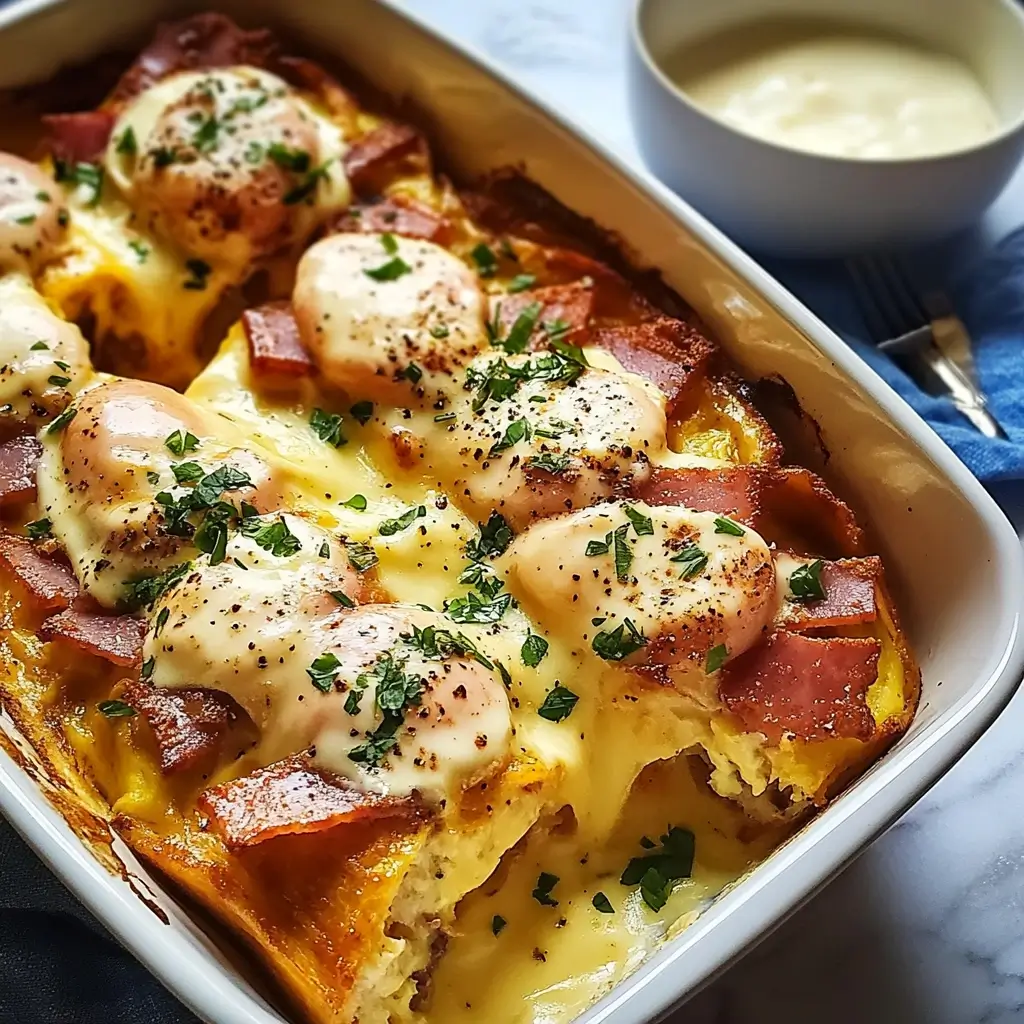Let me tell you a little secret – brunch at our house used to be a bit… chaotic. Everyone loves eggs benedict, but individually poaching eggs for a crowd? Forget about it! Then I stumbled upon the magic of the Eggs Benedict Casserole. Honestly, it was a game-changer. The first time I made it, the aroma alone had everyone practically glued to the kitchen. And the taste? Everything you love about classic eggs benedict – the creamy hollandaise, the salty ham, the perfectly cooked eggs, all nestled on a bed of toasted English muffins – but in an easy-to-serve, crowd-pleasing casserole form. My family devoured it, and it has since become a staple for holidays, weekend brunches, and even just a special “we deserve something amazing” kind of morning. If you’re looking for a brunch dish that’s both impressive and surprisingly simple, look no further. This Eggs Benedict Casserole is about to become your new favorite too.
Ingredients
To create this brunch masterpiece, gather these fresh and flavorful ingredients. We’ve broken it down for you, ensuring you have everything you need for the perfect Eggs Benedict Casserole. Quality ingredients truly elevate this dish, so choose the best you can find.
- For the Casserole Base:
- 12 English Muffins, split and toasted: English muffins form the foundation of our casserole, providing that signature Benedict texture. Look for good quality muffins that will hold their shape. Sourdough English muffins can add a delightful tang if you prefer.
- 1 pound Cooked Ham, diced: Ham is the classic choice for Eggs Benedict, offering a salty and savory element. You can use leftover holiday ham, deli ham, or even Canadian bacon for a leaner option. For a vegetarian twist, consider sautéed mushrooms or roasted red peppers.
- 1 cup Shredded Cheese (Swiss, Gruyere, or Monterey Jack recommended): Cheese adds a creamy, melty layer that binds the casserole together and complements the other flavors. Swiss or Gruyere offer a nutty, classic flavor, while Monterey Jack provides a milder, meltier option. A blend of cheeses works wonderfully too.
- 6 large Eggs, beaten: Beaten eggs are incorporated into the casserole base to add richness and help bind the ingredients. Use fresh, large eggs for the best results.
- 1 cup Milk or Half-and-Half: Milk or half-and-half adds moisture and creaminess to the casserole base. Half-and-half will create a richer, more decadent texture. For a lighter option, use whole milk.
- 1 teaspoon Dijon Mustard: Dijon mustard provides a subtle tang and depth of flavor that enhances the overall taste profile. It balances the richness of the hollandaise and eggs.
- 1/2 teaspoon Salt: Salt is essential for seasoning and bringing out the flavors of all the ingredients. Adjust to your taste.
- 1/4 teaspoon Black Pepper: Freshly ground black pepper adds a touch of spice and complements the salt.
- For the Poached Eggs:
- 12 large Eggs: The star of Eggs Benedict, these eggs will be gently poached on top of the casserole, delivering that iconic runny yolk. Ensure your eggs are very fresh for the best poaching results.
- For the Hollandaise Sauce:
- 1 cup (2 sticks) Unsalted Butter, melted: Butter is the foundation of a rich and luscious hollandaise sauce. Use unsalted butter to control the saltiness of the sauce.
- 4 large Egg Yolks: Egg yolks are the emulsifying agent in hollandaise, creating its creamy texture. Use fresh, large egg yolks.
- 2 tablespoons Lemon Juice, freshly squeezed: Lemon juice provides the essential acidity that balances the richness of the butter and egg yolks. Freshly squeezed juice is highly recommended for the best flavor.
- 1/2 teaspoon Salt: Salt seasons the hollandaise and enhances the other flavors.
- 1/4 teaspoon White Pepper or Cayenne Pepper (optional): White pepper provides a classic, subtle spice, while a pinch of cayenne pepper adds a gentle warmth. Use white pepper for a traditional hollandaise look and flavor.
- Optional Garnishes:
- Fresh Parsley, chopped: Chopped fresh parsley adds a pop of color and freshness, enhancing the visual appeal and providing a subtle herbaceous note.
- Paprika: A sprinkle of paprika adds a touch of color and a mild smoky flavor.
- Chives, chopped: Chopped chives offer a delicate oniony flavor and another element of freshness.
- Everything Bagel Seasoning: For an extra flavorful sprinkle, everything bagel seasoning can add a savory and crunchy element.
Instructions
Follow these step-by-step instructions to create your perfect Eggs Benedict Casserole. Each step is designed for ease and clarity, ensuring even beginner cooks can achieve brunch success.
- Preheat Oven and Prepare Baking Dish: Preheat your oven to 350°F (175°C). Grease a 9×13 inch baking dish. This ensures the casserole doesn’t stick and cooks evenly. A glass or ceramic baking dish works best.
- Assemble the Casserole Base: Arrange the toasted English muffin halves in the prepared baking dish, cut-side up, creating a single layer. Distribute the diced ham evenly over the English muffins. Sprinkle the shredded cheese generously over the ham.
- Prepare Egg Mixture: In a medium bowl, whisk together the beaten eggs, milk or half-and-half, Dijon mustard, salt, and pepper until well combined. This mixture will soak into the English muffins and create a flavorful base.
- Pour Egg Mixture over Casserole: Pour the egg mixture evenly over the English muffins, ham, and cheese, ensuring all ingredients are moistened. Gently press down on the English muffins with a spatula to help them absorb the liquid.
- Bake the Casserole: Bake in the preheated oven for 25-30 minutes, or until the casserole is set and lightly golden brown. The center should be just set, and the edges should be slightly browned. A knife inserted into the center should come out mostly clean.
- Prepare the Poached Eggs (While Casserole Bakes): While the casserole is baking, prepare your poached eggs. Fill a large, deep skillet with about 3 inches of water and bring to a gentle simmer. Add a splash of vinegar (optional, but helps eggs hold their shape). Crack each egg into a small ramekin or bowl. Gently swirl the simmering water to create a vortex, and carefully slip each egg into the center of the vortex, one at a time. Poach for 3-4 minutes for runny yolks, or longer for firmer yolks, depending on your preference. Remove poached eggs with a slotted spoon and place them on a plate lined with paper towels to drain excess water.
- Make the Hollandaise Sauce (While Eggs Poach): Prepare the hollandaise sauce while the eggs are poaching or just before serving. In a heatproof bowl set over a saucepan of simmering water (double boiler method), whisk together the egg yolks and lemon juice until pale and slightly thickened. Gradually whisk in the melted butter, a little at a time, whisking constantly until the sauce is smooth, thick, and emulsified. Be patient and whisk vigorously to prevent the sauce from separating. Season with salt and white pepper or cayenne pepper to taste. If the sauce becomes too thick, whisk in a teaspoon of warm water to thin it out.
- Assemble and Serve: Once the casserole is baked and the poached eggs and hollandaise sauce are ready, remove the casserole from the oven. Gently place a poached egg on top of each square of casserole. Generously drizzle hollandaise sauce over the poached eggs and casserole.
- Garnish and Serve Immediately: Garnish with chopped fresh parsley, paprika, chives, or everything bagel seasoning, if desired. Serve immediately while the casserole is warm and the hollandaise is creamy. This dish is best enjoyed fresh.
Nutrition Facts
(Note: Nutritional information is an estimate and can vary based on specific ingredients and serving sizes.)
Servings: Approximately 12 servings
Calories per serving: Approximately 450-550 calories
- Estimated Macronutrients per serving (approximate):
- Protein: 25-30g
- Fat: 30-40g
- Carbohydrates: 20-30g
This Eggs Benedict Casserole provides a satisfying and protein-rich brunch option. It’s important to note that hollandaise sauce is calorie-dense due to its butter content. For a slightly lighter version, you could use a reduced-fat hollandaise recipe or adjust the amount of hollandaise sauce served per portion. Consider pairing this casserole with a fresh fruit salad or a light green salad to balance the richness and add fiber to your meal.
Preparation Time
- Prep Time: 30 minutes (includes toasting muffins, dicing ham, grating cheese, whisking egg mixture, and poaching eggs)
- Cook Time: 25-30 minutes (baking casserole)
- Total Time: Approximately 55-60 minutes
This Eggs Benedict Casserole is relatively quick to assemble and bake, making it a great option for weekend brunches or special occasions. The most time-consuming part is poaching the eggs and making the hollandaise sauce, but both can be done efficiently while the casserole bakes, streamlining the overall preparation process. You can also save time by using pre-made hollandaise sauce, although homemade sauce definitely elevates the dish.
How to Serve
This Eggs Benedict Casserole is delicious on its own, but to create a truly memorable brunch spread, consider these serving suggestions:
- Side Dishes:
- Fresh Fruit Salad: A vibrant and refreshing fruit salad with berries, melon, and grapes provides a light and healthy contrast to the richness of the casserole.
- Roasted Asparagus: Tender roasted asparagus with a drizzle of lemon and olive oil adds a touch of green and earthy flavor.
- Hash Browns or Roasted Potatoes: Crispy hash browns or roasted potatoes complement the casserole beautifully and add a satisfying carbohydrate element.
- Green Salad with Vinaigrette: A simple green salad with a light vinaigrette dressing offers freshness and balance.
- Bacon or Sausage: For meat lovers, crispy bacon or savory sausage can be served alongside the casserole for an even heartier brunch.
- Beverages:
- Mimosa or Bellini: Classic brunch cocktails like mimosas or bellinis perfectly complement the Eggs Benedict Casserole.
- Bloody Mary: A savory Bloody Mary is another popular brunch beverage that pairs well with the rich flavors of the casserole.
- Freshly Squeezed Orange Juice: A refreshing and healthy option to start the day.
- Coffee or Tea: Essential brunch beverages to complete the meal.
- Sparkling Water with Lemon or Lime: A light and refreshing non-alcoholic option.
- Serving Style:
- Buffet Style Brunch: This casserole is perfect for a buffet-style brunch. Keep the casserole warm in a chafing dish or on a warming tray if serving a crowd.
- Individual Plates: Serve individual squares of the casserole on plates, ensuring each serving has a poached egg and generous hollandaise sauce.
- Garnish Station: Set up a garnish station with chopped parsley, paprika, chives, and other toppings so guests can customize their servings.
Additional Tips for Eggs Benedict Casserole Success
- Toast the English Muffins Properly: Don’t skip toasting the English muffins! Toasting them lightly before assembling the casserole prevents them from becoming soggy and adds a pleasant texture. You want them lightly golden but not overly browned.
- Don’t Overbake the Casserole: Overbaking can lead to dry eggs and a tough texture. Bake until the casserole is set and lightly golden brown, but still slightly moist in the center. The residual heat will continue to cook it.
- Fresh Eggs are Key for Poaching: Use the freshest eggs possible for poaching. Fresher eggs hold their shape better and result in more beautiful poached eggs. If you are unsure of egg freshness, you can add a teaspoon of white vinegar to the poaching water; it helps the egg whites coagulate faster.
- Make Hollandaise Sauce Just Before Serving: Hollandaise sauce is best served fresh and warm. It can be made ahead of time and kept warm (using a double boiler or very low heat, whisking occasionally), but it’s ideal to prepare it right before serving for the best texture and flavor. If it separates, try whisking in a tablespoon of ice water to re-emulsify.
- Customize Your Casserole: Feel free to customize this recipe to your liking! Experiment with different cheeses, meats (like bacon, sausage, or smoked salmon), or add-ins like sautéed spinach, mushrooms, or caramelized onions to the casserole base. For a spicier kick, add a pinch of cayenne pepper to the hollandaise or casserole base.
Frequently Asked Questions (FAQ)
Q1: Can I make Eggs Benedict Casserole ahead of time?
A: Yes, you can prepare the casserole base (up to step 4 in the instructions) and assemble it the night before. Cover and refrigerate it overnight. In the morning, bake as directed, adding a few extra minutes to the baking time as it will be starting from cold. However, it’s best to poach the eggs and make the hollandaise sauce fresh just before serving for optimal quality.
Q2: Can I use store-bought hollandaise sauce?
A: Yes, for convenience, you can use a high-quality store-bought hollandaise sauce. While homemade hollandaise is undeniably superior in flavor, store-bought versions can save time, especially when you are busy. Look for refrigerated hollandaise sauces in the grocery store’s dairy or refrigerated sauce section for better quality than shelf-stable options.
Q3: How do I keep the poached eggs warm if I make them ahead?
A: Poached eggs are best served immediately. If you need to poach them ahead of time, you can gently reheat them. Poach them slightly underdone (about 2-3 minutes for runny yolks). Then, transfer them to an ice bath to stop the cooking process. When ready to serve, gently reheat them in warm (not boiling) water for about 30-60 seconds until warmed through.
Q4: Can I freeze Eggs Benedict Casserole?
A: It is not recommended to freeze the assembled Eggs Benedict Casserole with the poached eggs and hollandaise sauce, as the texture of the eggs and sauce will likely degrade upon thawing. However, you can freeze the casserole base (without the poached eggs and hollandaise) after baking and cooling it completely. Wrap it tightly in freezer-safe wrap and then foil. Thaw overnight in the refrigerator and reheat in the oven. Add freshly poached eggs and hollandaise sauce before serving.
Q5: What if my hollandaise sauce breaks or separates?
A: Hollandaise sauce can sometimes separate (emulsion breaks) if it gets too hot or is not whisked properly. If your sauce separates, don’t panic! You can often fix it. Remove the bowl from the heat. In a separate bowl, whisk 1-2 tablespoons of ice water. Slowly drizzle the broken hollandaise sauce into the ice water, whisking constantly and vigorously. The cold water can help re-emulsify the sauce. Alternatively, you can whisk in another egg yolk to help stabilize the sauce. Prevention is key – whisk constantly and don’t overheat the sauce.
This Eggs Benedict Casserole is more than just a recipe; it’s an experience. It’s the joy of gathering around the table with loved ones, the aroma of delicious food filling the air, and the satisfaction of creating something truly special. So, gather your ingredients, follow these steps, and prepare to impress with this brunch showstopper. Enjoy!
Print
Eggs Benedict Casserole Recipe
Ingredients
- For the Casserole Base:
- 12 English Muffins, split and toasted: English muffins form the foundation of our casserole, providing that signature Benedict texture. Look for good quality muffins that will hold their shape. Sourdough English muffins can add a delightful tang if you prefer.
- 1 pound Cooked Ham, diced: Ham is the classic choice for Eggs Benedict, offering a salty and savory element. You can use leftover holiday ham, deli ham, or even Canadian bacon for a leaner option. For a vegetarian twist, consider sautéed mushrooms or roasted red peppers.
- 1 cup Shredded Cheese (Swiss, Gruyere, or Monterey Jack recommended): Cheese adds a creamy, melty layer that binds the casserole together and complements the other flavors. Swiss or Gruyere offer a nutty, classic flavor, while Monterey Jack provides a milder, meltier option. A blend of cheeses works wonderfully too.
- 6 large Eggs, beaten: Beaten eggs are incorporated into the casserole base to add richness and help bind the ingredients. Use fresh, large eggs for the best results.
- 1 cup Milk or Half-and-Half: Milk or half-and-half adds moisture and creaminess to the casserole base. Half-and-half will create a richer, more decadent texture. For a lighter option, use whole milk.
- 1 teaspoon Dijon Mustard: Dijon mustard provides a subtle tang and depth of flavor that enhances the overall taste profile. It balances the richness of the hollandaise and eggs.
- 1/2 teaspoon Salt: Salt is essential for seasoning and bringing out the flavors of all the ingredients. Adjust to your taste.
- 1/4 teaspoon Black Pepper: Freshly ground black pepper adds a touch of spice and complements the salt.
- For the Poached Eggs:
- 12 large Eggs: The star of Eggs Benedict, these eggs will be gently poached on top of the casserole, delivering that iconic runny yolk. Ensure your eggs are very fresh for the best poaching results.
- For the Hollandaise Sauce:
- 1 cup (2 sticks) Unsalted Butter, melted: Butter is the foundation of a rich and luscious hollandaise sauce. Use unsalted butter to control the saltiness of the sauce.
- 4 large Egg Yolks: Egg yolks are the emulsifying agent in hollandaise, creating its creamy texture. Use fresh, large egg yolks.
- 2 tablespoons Lemon Juice, freshly squeezed: Lemon juice provides the essential acidity that balances the richness of the butter and egg yolks. Freshly squeezed juice is highly recommended for the best flavor.
- 1/2 teaspoon Salt: Salt seasons the hollandaise and enhances the other flavors.
- 1/4 teaspoon White Pepper or Cayenne Pepper (optional): White pepper provides a classic, subtle spice, while a pinch of cayenne pepper adds a gentle warmth. Use white pepper for a traditional hollandaise look and flavor.
Instructions
- Preheat Oven and Prepare Baking Dish: Preheat your oven to 350°F (175°C). Grease a 9×13 inch baking dish. This ensures the casserole doesn’t stick and cooks evenly. A glass or ceramic baking dish works best.
- Assemble the Casserole Base: Arrange the toasted English muffin halves in the prepared baking dish, cut-side up, creating a single layer. Distribute the diced ham evenly over the English muffins. Sprinkle the shredded cheese generously over the ham.
- Prepare Egg Mixture: In a medium bowl, whisk together the beaten eggs, milk or half-and-half, Dijon mustard, salt, and pepper until well combined. This mixture will soak into the English muffins and create a flavorful base.
- Pour Egg Mixture over Casserole: Pour the egg mixture evenly over the English muffins, ham, and cheese, ensuring all ingredients are moistened. Gently press down on the English muffins with a spatula to help them absorb the liquid.
- Bake the Casserole: Bake in the preheated oven for 25-30 minutes, or until the casserole is set and lightly golden brown. The center should be just set, and the edges should be slightly browned. A knife inserted into the center should come out mostly clean.
- Prepare the Poached Eggs (While Casserole Bakes): While the casserole is baking, prepare your poached eggs. Fill a large, deep skillet with about 3 inches of water and bring to a gentle simmer. Add a splash of vinegar (optional, but helps eggs hold their shape). Crack each egg into a small ramekin or bowl. Gently swirl the simmering water to create a vortex, and carefully slip each egg into the center of the vortex, one at a time. Poach for 3-4 minutes for runny yolks, or longer for firmer yolks, depending on your preference. Remove poached eggs with a slotted spoon and place them on a plate lined with paper towels to drain excess water.
- Make the Hollandaise Sauce (While Eggs Poach): Prepare the hollandaise sauce while the eggs are poaching or just before serving. In a heatproof bowl set over a saucepan of simmering water (double boiler method), whisk together the egg yolks and lemon juice until pale and slightly thickened. Gradually whisk in the melted butter, a little at a time, whisking constantly until the sauce is smooth, thick, and emulsified. Be patient and whisk vigorously to prevent the sauce from separating. Season with salt and white pepper or cayenne pepper to taste. If the sauce becomes too thick, whisk in a teaspoon of warm water to thin it out.
- Assemble and Serve: Once the casserole is baked and the poached eggs and hollandaise sauce are ready, remove the casserole from the oven. Gently place a poached egg on top of each square of casserole. Generously drizzle hollandaise sauce over the poached eggs and casserole.
- Garnish and Serve Immediately: Garnish with chopped fresh parsley, paprika, chives, or everything bagel seasoning, if desired. Serve immediately while the casserole is warm and the hollandaise is creamy. This dish is best enjoyed fresh.
Nutrition
- Serving Size: one normal portion
- Calories: 450-550
- Fat: 30-40g
- Carbohydrates: 20-30g
- Protein: 25-30g



